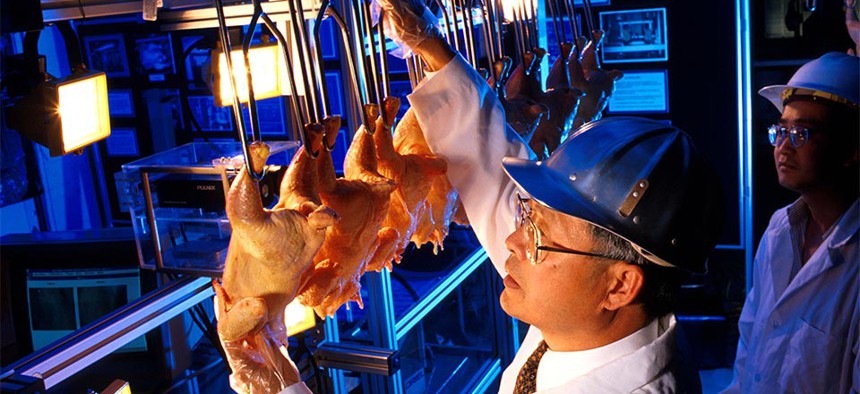USDA: Media Is Misinterpreting Report on Poultry Inspection Reforms
Auditors found nothing to discredit accelerated and privatized procedures, department argues.
New poultry and hog inspection procedures designed to improve efficiency and food safety cannot be reliably evaluated without better data, auditors concluded in a report released Wednesday, prompting an Agriculture Department official to publish a contrasting view.
The Government Accountability Office found that the data the Food Safety and Inspection Service is using in three pilot programs for the new procedures is in some cases 10 or 20 years old. USDA, which has been running the pilots for 15 years, performed a cost-benefit analysis and in January 2012 published a proposed rule to implement the new procedures without addressing the lack of timely and comprehensive data.
USDA “has not thoroughly evaluated the performance of each of the pilot projects over time even though the agency stated it would do so when it announced the pilot projects,” the auditors found, noting that some of the data sets were “snapshots” covering just two years and that no data were gathered at some of the smaller young chicken and turkey plants.
GAO did identify strengths in the program as cited by 11 stakeholder groups representing industry, labor, consumer advocacy and animal welfare interests. But it also said it had “identified weaknesses including that training of plant personnel assuming sorting responsibilities on the slaughter line is not required or standardized and that faster line speeds allowed under the pilot projects raise concerns about food safety and worker safety.”
The report was requested by Sen. Kirsten Gillibrand, D-N.Y., who chairs the Agriculture Subcommittee on Livestock, Dairy, Poultry, Marketing and Agriculture Security. On Wednesday, she sent a letter to the White House Office of Information and Regulatory Affairs saying the proposed rule was “not formulated on a strong scientific basis” and asked that it be delayed and re-evaluated.
GAO recommended that the department gather the missing data and publicly disclose any limitations, and program managers agreed.
But on Wednesday, Al Almanza, administrator of the Food Safety and Inspection Service, published a critique of the way the GAO report was being portrayed in the news media. “While an initial scan of the press coverage may lead you to believe that GAO discredits this proposal, that is not the case. GAO gave [the pilot inspection reforms] a thorough review and made just two recommendations, both of which FSIS is already working to fulfill,” he wrote.
“GAO’s report also assumes that the basis for moving forward with this proposal is to improve efficiency and save taxpayer dollars,” he said. “Although it does accomplish both of those things, as FSIS made clear to GAO, this proposal is first and foremost about making food safer.”
Almanza said the new system will prevent “at least 5,000 more foodborne illnesses annually” and has been backed by an independent panel of experts. The data show, he added, that “fecal material, the primary avenue for pathogen contamination, appears about half as often” in the pilot inspection plants as in the non-pilot plants, and that inspections for fecal material are four times as frequent under the reformed system. In addition, the Salmonella rate is 20 percent lower in plants using the pilot reforms.
“If finalized and implemented broadly, this new inspection system would enable FSIS to better fulfill our food safety mission,” he wrote. “Nothing in the GAO’s report contradicts this basic fact.”
NEXT STORY: How to Rebuild an Attention Span




